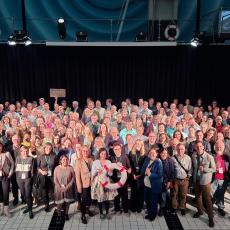Welcome to the Swiss municipality with a democratic secret: in Arth-Goldau in central Switzerland citizens are truly in charge, by combining pre-modern forms of assembly democracy with modern ballot style direct democracy. Stephanie Hess reports.
Nestled between deep blue Lake Zug, majestic Mount Rigi and the greenery of farmland and forests, the villages of Goldau, Oberarth and Arth in canton Schwyz look typically Swiss. Yet their citizens have a hybrid form of democracy that is almost unique within Switzerland.
Rather than voting with a show of hands, the pre-modern archetype of democracy and method used in many of the nation´s over 2,350 municipalities, the people here vote by secret ballot. This is the case in nearly all 30 municipalities in canton Schwyz.
While larger municipalities usually have a parliament, most small and medium-sized ones hold public meetings twice a year so that residents can make decisions about the fate of their village. There, the local government presents the issues, and the citizens vote on them. A raised hand signals approval. But in Arth, this is only the case for the budget and other municipal finance questions. For other issues, the town hall meetings are an opportunity for citizens to ask questions of the local authorities. Decisions aren't made until the next official vote day, where citizens cast their secret ballots.
19th century heritage
In the canton of Schwyz, the foundation for this combination of old-style assembly democracy and modern ballot box voting was laid already at the end of the last century. Reflecting the democratic movement, the first mention of districts and municipalities introducing secret vote ballots came in the Schwyz cantonal constitution of 1898. This was to ensure that the voters - only men at that time - could express their opinions freely without having to worry about repercussions. Shortly after the turn of the century, two Schwyz districts adopted the ballot box system. Probably not for democratic reasons, but rather for reasons of power. "In both places, the conservatives were able to displace the previously dominant liberals", explains Erwin Horat, director of Schwyz´s state archives.
Among conservatives, the ballot box system still seems popular. As political scientist Oliver Dlabac of the Centre for Democracy Studies Aarau points out, the municipalities of canton Lucerne have completely switched to this system in recent years. This was thanks to the efforts of local representatives of the conservative right Swiss Peoples Party.
Decision day
In canton Schwyz, lots of people are in action at official voting meetings - including September 25, 2016, one of the four nationwide voting dates. In Arth, two women and a man sit beside the ballot box at the entrance of the school gymnasium. Citizens who didn't vote by mail drop by to cast their votes. In another room, about 15 people are counting the ballots. They process not only the municipal polls, but also district, cantonal and federal. This time there are seven issues; sometimes it´s eight or nine. "Sometimes it´s a little much", says a resident after casting his ballot and swinging back onto his bicycle. "It takes a lot of effort to be fully informed on each subject."
Actually, the municipal assembly is the place to get comprehensive information. But the number of voters who actually find their way there has been declining for years - not only in Arth, but in nearly all municipalities with assembly democracy. According to Mayor Ruedi Beeler, attendance is down to about 100 or 200 people per meeting. Arth has a population of 10,000.
Here lies the key point of criticism for this style of democracy - that the ballot box system undermines the power of the community meetings with their consultations and discussions. "The combined system is more like pure ballot box democracy, as is common in communities with parliaments. But it has the distinct disadvantage that during a town hall meeting, the electorate is less certain to be represented than it would be with an elected parliament", says Dlabac. The keywords here are low participation and poor representation of certain population groups, like women and young people. So the question is whether the mixed form, as used in communities in Schwyz, has more advantages or disadvantages.
"That depends on participation at the municipal assemblies, and also on the vitality of the public debate outside of those meetings", says Dlabac, noting that a principal advantage of the ballot box system is turnout, which is usually higher than it would be with a show of hands. "This ensures a broader legitimacy of the results."
In Arth, the citizens seem to like the system. On election day, people stop for a chat near the ballot box - enquiring about the health of relatives. Until the bells of the nearby church begin to ring, calling people to Sunday service. Some head for the pews, others to the village centre. "For brunch", explains a man with a smile. "Going to the polls is also a good chance to visit the village." And to discuss politics? "At least a little bit."
Stephanie Hess wrote this piece for our hosting partner swissinfo, where you also can find editions of it in French, German, Chinese, Portuguese, Japanese, Italian, Spanish, Arab and Russian.


